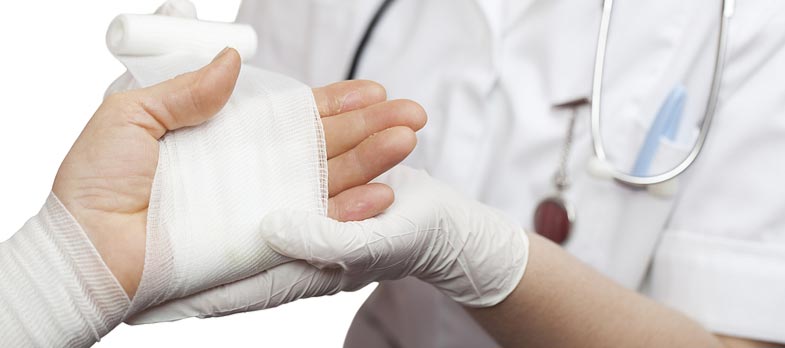There are several reasons why serious burns are among the most common catastrophic injuries in truck crash cases. Most 18-wheelers carry about 300 gallons of fuel, and fully-loaded tanker trucks may carry as much as 9,000 gallons. The sheer volume is one reason why many large truck crashes involve large fireballs. But that is only part of the story. In many cases, diesel fuel burns at a different temperature, and for a much longer time, than gasoline. Finally, because of the tractor-trailer’s weight, many injured victims are pinned inside their vehicles until first responders can sufficiently extinguish the flames to allow extrication. So, instead of being exposed to flaming fuel for a few seconds, many victims are exposed for several minutes or even much longer.
Burns and scars are nearly always considered “permanent” injuries under 627.737 of the Florida Statutes (a.k.a. the “no-fault law”), and examining how these injuries are treated helps explain why these victims may be entitled to additional compensation.
Different Types of Burns
Children and senior citizens are the most at-risk age groups for serious burns. To put it succinctly, these kinds of injuries damage the skin, which the body counts on to regulate body temperature, store fat, prevent water loss, and perform other necessary functions. There are four different kinds of burns:
- First Degree: Sunburn is perhaps the most common first degree burn. The skin is discolored and somewhat painful, but there is no blistering because these injuries only affect the top skin layer.
- Second Degree: These wounds affect the epidermis (top layer) and part of the dermis (bottom layer). In practical terms, these burns require first aid and sometimes hospitalization to deal with the blistering, swelling, and pain.
- Third Degree: These injuries completely destroy the epidermis and dermis, leaving the skin charred and disfigured.
- Fourth Degree: Some burns reach all the way to bones, tendons, and muscles. These injuries are not as painful as lesser-degree burns because the nerve endings are destroyed.
Serious third- and fourth-degree burns always require skin grafts and other aggressive medical treatments, in addition to months of painful and expensive physical therapy. These latter two types of injuries are the ones that most frequently occur in large truck-involved crashes.
Treating Burn Injuries, Step One
Severe burn victims require extensive care. Because these people can no longer regulate their own body temperatures or remain hydrated, these functions must be carried out by artificial means. Once the victims are stabilized, doctors often rely on debridement (the removal of dead skin at the point of injury) to help facilitate healing. This is the first step in burn injury healing, and it involves one of four processes:
- Autolytic (dressings),
- Surgical,
- Enzymatic,
- Mechanical (water therapy), and
- Biological.
Typically, only first-degree and some second-degree burns respond to autolytic methods. More serious burns, like the ones commonly associated with truck crashes, require more advanced inpatient debridement.
In personal injury cases, insurance adjusters often readily approve common surgical debridement because it is typically the least expensive advanced option. If the doctors feel that the victim’s injuries demand a more sophisticated response, the adjuster nearly always argues that the treatments were not medically necessary. In these cases, an attorney sometimes partners with an independent medical expert who will support the treating physician’s assessments and conclusions.
Treating Burn Injuries, Step Two
After debridement gets the victim ready to heal, the second stage is quite literally just a matter of time. Most victims must remain hospitalized under controlled conditions for at least a little while as scars begin to form. Initially, a light skin-like layer forms over the exposed area. Most victims are almost completely immobilized during this phase, because any dirt or damage to the delicate new skin may completely derail the recovery process just as it is beginning.
Over the next three or four months, the scar tissue starts to rise and harden. Then, over the next year or so, the scars mature into their final form. As the skin gets stronger, victims can begin rehabilitative therapy to minimize the appearance of scarring. This therapy typically includes deep massage, stretching exercises, and specialized bandages. Once the doctor lays out the appropriate physical therapy regimen, the victim must adhere to it religiously because any lessening has a dramatic effect on the results.
Until recently, even the most aggressive medical treatment and physical therapy had its limits. But new techniques may be available to improve long-term results, particularly in extreme cases. Specialists are constantly refining skin graft techniques to improve outcomes and lessen recovery time. In coming years, even more advanced techniques involving 3D printing will probably be available. After the medical intervention ends, there are a number of live and online support groups where recovering victims can find additional resources to help them through life.
At Barnett, Lerner, Karsen & Frankel, we help ensure that victims and their families have the financial resources they need to completely recover from their injuries. Contact us today for a free consultation.

